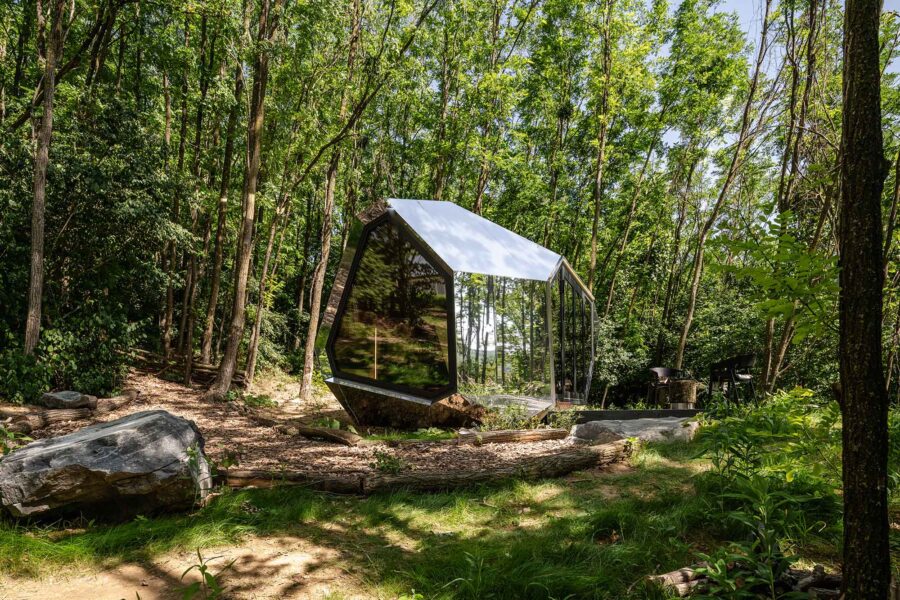
CULTURE


© vinay panjwani

© vinay panjwani
〈Cocoon, Pre-primary Extension〉は、インドの都市ヴィジャヤワダに位置するブルーミングデール・インターナショナル・スクール(Bloomingdale International School)の敷地内に建てられた、未就学児のための学校建築です。
内部支持や間仕切りのない、遮るもののない空間と特徴的な湾曲した屋根が遊ぶスペースと学ぶスペースをシームレスに融合させつつ、フルハイトのガラスにより内外の境界が曖昧な空間を生み出しています。
インドのアーメダバードを拠点に活動するアンドブラック・デザイン・スタジオ(andblack design studio)が設計した、コンピュテーショナル・デザインとプレファブリケーションという現代的なテクノロジーを活用することで、このユニークな空間を限られた予算の中で実現した建築です。
(以下、andblack design studioから提供されたプレスキットのテキストの抄訳)

© vinay panjwani
教育の限界を押し広げる型破りな建築
インドの都市ヴィジャヤワダのブルーミングデール・インターナショナル・スクールは、伝統的な教育システムが支配的なこの地域において、パラメトリック建築が教育の限界を押し広げ、従来の常識に挑戦することで、その変革力を浮き彫りにしている。
このインターナショナル・スクールは、型にはまらない教育を提供するというビジョンをコア・バリューとし、地域の他のプレスクールが提供する以上のものを提供することを心情としている。そして〈Cocoon, Pre-primary Extension〉は、考え抜かれた建築デザインを通じて、幼児教育にパラダイム・シフトをもたらそうというものである。

© vinay panjwani

© vinay panjwani
〈Cocoon, Pre-primary Extension〉は、キャンパス内の既存の校舎に隣接する4,000ft²(約370m²)のエリアを占めており、この2つの建物をつなぐ中庭は、敷地の地形に沿って、まるで丘を登るように新しい増築部分に向かって上っている。
この配置は、約100人の未就学児に対応するとともに、建築家たちにこの学校のキャンパスならではのものを開発するユニークな機会を提供し、その結果、学校とはどうあるべきかという概念に挑戦するデザインが生まれた。従来とは異なる空間構成、近代的な技術、耐久性の高い素材を用い、建築物、ランドスケープ、インテリアを一体化させることで、それを実現している。

© vinay panjwani

© vinay panjwani
教室同士だけでなく内外もつなぐ流動的な空間
この建築は、通常の箱のような教室ではなく、教室を流動的で相互につながった空間としてレイアウトし、自由な動きと交流を促進しており、遊ぶスペースと学ぶスペースをシームレスに融合させ、両者の境界線を曖昧にしている。中庭は、遊び場として、教室として、円形劇場として、時には水たまりのプールとして、状況やニーズに応じて利用される。
このようなユニークな空間体験は、壁ではなくフルハイトのガラスパネルを用い、屋根に天窓を設けることでさらに高められている。どこまでが内部でどこまでが外部か、という認識を完全に排除しており、ランドスケープと建築空間を互いの延長としている。

© vinay panjwani

© vinay panjwani
従来の学校建築と一線を画すもう1つのポイントは、視覚的な興味を喚起するために用いられる鮮やかな色彩の代わりに、造形を利用していることにある。この考え方の中心には、 「建物はランドスケープの一部ではなく、それ自体がランドスケープとしてあるべきである」という思いがある。
この考えは、波やなだらかな丘陵を模した湾曲した起伏のある屋根に大きく反映されている。この建物を遠くから眺めると、その奥に広がる風景が垣間見え、建物自体が風景の一部であるかのように感じられる。
そしてこの湾曲した屋根は、建物の中で過ごす子供たちを、まるで繭のように守っているのである。

© vinay panjwani

© vinay panjwani
デザインを実現するコンピュテーショナル・デザインとプレファブリケーション
内部支持や間仕切りのない、遮るもののない空間の上に乗っている、芝で覆われた屋根の流動的な形状は、コンピュテーショナル・ツールを用いて構想された。
その独創性は、緑の表面が他の建築物からいかに逸脱し、この地域のランドマークとなっているかにある。さらに、入手しやすい資源や技術を考慮した効率的な建設プロセスを採用することにより、限られた予算でこの建築を実現した。

Isometric Exploded
プレファブリケーション部材を使用していることも、デザインの重要な側面である。屋根の構造コアは、プレファブリケーション部材と、X軸とY軸に沿って曲げられた円形中空セクションの各交点に独自の接合プレートを配置する建設技術を駆使して現場で組み立てられた。
必要な曲率は、精密に製作され組み立てられた接合部により高さを変えることで達成された。滑らかな外皮を実現するための構造の複雑さは、ユニークな金属構造の上に一体化されたフェロセメントのシェル(編集部註:主に船体に使用される素材および技術)によって解決された。

Pipe – Column Junction

CHS Unique Assembly
この構造を内部から見ると、屋根は不思議かつ神秘的な感覚を同時に生み出している。天井に沿って露出した構造部材は、芝生を敷き詰めた外皮との美しいコントラストを生み出し、素材の持ち味を輝かせている。
天窓から差し込む自然光がシームレスな曲面を際立たせ、各教室のアンカーポイントとなっている。一日を通して教室内に拡散する光と影の動きは、デザインにもう1つの遊び心を加えている。

© vinay panjwani
この学校建築は、構造的な表現、デザインの革新性、型にはまらないアプローチなどの面でユニークであり、教育空間の概念を刷新し、利用者にインパクトを与えるために、あらゆる部分が考え抜かれた設計となっている。
フルハイトのガラスパネルと芝生の屋根の使用、教室の流動的な空間構成、プレファブリケーション製造とコンピュテーショナル技術の使用、パラメトリックな建築形態は、「典型的な箱型建築」から逸脱し、子供たちの好奇心を持続させる、個性的で型破りで遊び心のある構造をつくり出している。
これにより、ブルーミングデール・インターナショナル・スクールは、建築の力を活かして未来の教育空間を形づくる先駆けとして際立っている。

© vinay panjwani

© vinay panjwani

© vinay panjwani







以下、andblack design studioのリリース(英文)です。
Project Name:
Bloomingdale International School
Cocoon, Pre-primary ExtensionYear of Completion: 2024 (30/01/2024)
Location:
Chepalakundila Road, Penamaluru
Vijayawada, Andhra Pradesh
Pincode – 521137andblack team:
Jwalant Mahadevwala
Adity RawatStructural Consultant:
Shehzad Irani
Schafbock design+workshopPhotography:
Vinay Panjwanihttps://www.youtube.com/watch?v=gZJE2Y7cYOU
A harbinger of architectural influence on moulding the creation of upcoming educational environments.
In a region where traditional education systems dominate the sector, Bloomingdale International School in Vijayawada, highlights the transformative power of parametric architecture in pushing the boundaries of education and challenging the conventional norms. It is the first-of-its-kind institute, and the only International School in the state of Andhra Pradesh, India, that has: in its core value a vision to provide education that is unconventional by standards; in its heart to go beyond what other pre-schools in the region provide; and in its brief to bring a paradigm shift in the early education through thoughtful architectural design.
The pre-school occupies a 4000 sq. ft. area within the campus, adjoining the existing school building. Connecting the two buildings is a sunken courtyard, following the topography of the site and ascending towards the new extension as if climbing a hill. This site arrangement, along with the need to cater to about 100 pre-schoolers, offered the architects a unique opportunity to develop something that was unique to the school campus. The outcome is a design that challenges the notion of what a school should be. It does so by bringing the built form, landscape, and interiors together into a single entity, using non-conventional spatial organization, modern technology, and robust materials.In line with its vision, the architecture of Bloomingdale International School breaks away from the typical school design norms. Instead of the usual box-like classrooms, the layout envisions classrooms as fluid, interconnected spaces that foster free movement and interactions. The design seamlessly merges spaces for playing and learning, blurring the lines between the two. The courtyard adds to this effect by adapting itself as a playground, a classroom, an amphitheatre or a puddle pool as the function demands. These unique spatial experience is further enhanced by the use of full-height glass panels in place of walls and skylights in the roof. By doing so, the design completely eliminates the understanding of what is inside and what is outside, thereby making the landscape an extension of the built space and vice versa.
Another point of departure from conventional school architecture is the design’s reliance on built form instead of bright colors to generate visual interest. Central to this idea lies the thought: “the building, instead of being a part of the landscape, should be a form of the landscape in itself.” This is evident by the curved, undulating roof emulating a wave or perhaps rolling hills. When one views this building from a distance, the viewer can immediately catch glimpses of the landscape beyond, making the building seem like a part of the scene itself. A closer look reveals the real ingenuity of the design: kids inhabiting the building, as if protected within a cocoon.
The fluid form of the roof – covered in turf and resting on an unobstructed structural space devoid of any internal supports or partitions – has been conceptualized using computational tools. Its ingenuity lies in how the green surface outcasts the rest of the built form, making it a landmark in the area. Even more surprising, is the fact that the structure itself has been realized within a limited budget by adopting an efficient construction process that considers readily available resources and technologies.
Its reliance, especially, on prefabricated materials is another critical aspect of the design. The structural core of the roof has been erected on site using prefabricated elements and construction techniques that involved directing unique junction plates at each intersection of bent circular hollow sections along along the X and Y axes. Whereas the required curvature has been attained by varying the heights of precisely fabricated and assembled junctions. Structural complexities in achieving the smooth external skin were resolved with a ferrocement shell integrated above the unique metal structure.
When this structure is viewed from inside, the roof creates a captivating sense of wonder and mystery at the same time. Exposed structural elements along the ceiling present a beautiful contrast to the exterior turfed surface, thereby allowing the true character of materials to shine. The visual effect of this austere material palette is heightened by natural light dissipating through the skylights, punctuating the seamless curvature and creating an anchor point in each classroom. The movement of the light and shadow, diffusing in the classroom across the day, adds another playful element to the design.
The architecture of this school is unique in its structural expression, innovation in design and the resoluteness in its unconventional approach, where every part has been thoughtfully designed to reinvent the concept of educational spaces and leave an impression on its users. The use of full-height glass panels and turfed roof; fluid spatial organization of classrooms; reliance on prefabrication and computational technologies; and a parametric architectural form, deviate from ‘typical box building’, creating a distinct, non-conformist and playful structure that could keep childlike curiosity alive. In doing so, Bloomingdale International School stands as a harbinger of the power of architecture in shaping the design of future educational spaces.
andblack design studio 公式サイト
https://www.andblackstudio.com









